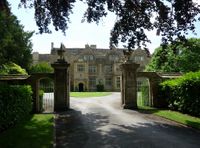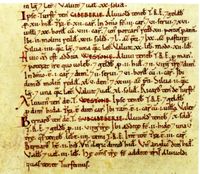History of the Barony & the Manor of North Cadbury, Somerset
The Barony & Manor of North Cadbury
The Barony of North Cadbury together with the Manor of Cadbury, which was attended to the Barony was mentioned in Domesday Book of 1086 as 'Cadeberie' and held as part of the considerable Barony of Turstin FitzRolf. The Barony of North Cadbury is also listed in the Cartae Baronum, the 'Charters of the Barons'. This was a survey commissioned by the treasury in 1166. In it, each baron had to state how many knights he had enfeoffed.
The Barony has a long and fascinating history and is kept alive by the current custodians, the 6th Baron and Baroness of North Cadbury, on behalf of the British Nation.
Keeping history alive
North Cadbury is a village 5 miles (8 km) WSW of Wincanton on the River Cam in the South Somerset district. The village has three landmarks: Cadbury House or North Cadbury Court dates back to 1300. It was rebuild to an Elizabethan Mansion by the third Earl of Huntingdon in the 1580's. The Church of St Michael the Archangel dates from 1417, but the Tower is build earlier in 1394. Both buildings are designated by English Heritage as Grade I listed buildings. The North Cadbury Hall Cottage dates to 1343 and is a Grade II* listed building.
North Cadbury (Cadeberie - Cada's Fort) takes its name from Cadbury Castle in South Cadbury and contains the eponymus village in the south, Galhampton village in the north, the dispersed hamlet of Woolston in the south-east, and a few scattered farmsteads and roadside cottages. In the fifth and sixth century Somerset lay in the Kingdom of Dumnonia and Cadbury means Cada's or Cado's Fort. In the time around King Arthur was born Cado was King of Dumnonia. There are evidence, also archaeologically that this site was an important military installation at that period. This Fort was built with massive stone walls and in the middle of the hilltop a great hall which was timber-framed. It was a very stately King's palace.
Myths & Legends of Cadbury in Somerset - A World full of Magic, Myths & Thruths
Cadbury Castle - formerly known as Camalet or also known as Camelot Castle has inspired storytellers and historians through the ages - sharing tales of magic, myth and mystery and historical facts. The Hill is a bronze and iron age hillfort in the civil parish of South Cadbury. It is a scheduled monument and associated with the legendary King Arthur. Legend has it that on midsummer's eve (23rd June) the hill turns clear as glass and inside can be seen King Arthur and his knights of the round table.
Prospect of Camalet Castle. 15.Aug.1723 hand-coloured engraving
"It is also be said by an ancient writer to have been one of the stations of the Round Table of King Arthur. The following account of this singular fraternity will be interesting to the reader: "This Round Table was kept at several places, especially at Caerleon in Monmouthshire, at Winchester, and at Camalet in Somersetshire."*
(*Source: THE HISTORY AND ANTIQUITIES OF SOMERSETSHIRE; BEING A GENERAL AND PAROCHIAL SURVEY OF THAT INTERESTING COUNTY. VOL. I. By Rev. W. Phelps. London 1836)
Creation of the Barony about A.D. 1066
Where it all began ...
The Conquest of England and the Battle of Hastings
More than 950 years ago - England's future was fought in the decisive Battle of 1066. The Battle of Hastings took place on 14 October 1066, in the northwest of Hastings, near to the present-day town Battle in East Sussex.
Shortly before the combat at Hastings
Robert Wace (c. 1110 - after 1174) a Norman poet, wrote in his chronicle Roman de Rou:
"The Duke called for the standard which the Pope had sent him, and, he who bore it having unfolded it, the Duke took it and called to Raoul de Conches to bear his standard. But Raoul refused that he would serve the Duke that day in other guise, and would fight the English with his hand as long as life should last. Then the Duke bade Walter Giffard bear the standard. But he was old and white-headed, and bade the Duke give the standard to some younger and stronger man to carry. Then he called out a knight, whom he had heard much praised, Tosteins Fitz-Rou le Blanc by name, whose abode was at Bec-en-Caux. To him he delivered the standard, and Tosteins took it right cheerfully, and bowed low to him in thanks, and bore it gallantly and with good heart. His kindred still have quittance of all service for their inheritance on this account, and their heirs are entitled so to hold their inheritance forever."
The Norman-French army of Duke William II of Normandy and the English army under the Anglo-Saxon King Harold Godwinson fought against each other and was a decisive Norman victory. This was the beginning the Norman conquest of England. After this significant battle with the death of King Harold, the Norman victory and the conquest of England, William the Conqueror devolved all the lands into administration to his loyal barons and lords. William sent forces into London to construct a castle, the Tower of London. He was crowned at Westminster Abbey on Christmas Day 1066, as King William I. This battle and the Norman conquest has changed England forever.
Creation of the Barony & History until Today
The feudal Barony of North Cadbury was created shortly after the Norman conquest of England in about 1066. King William established the extensive Barony of (North) Cadbury (Cadeberie) and granted Tosteins Fitz-Rou le Blanc (Turstin FitzRolf), the first feudal Baron of (North) Cadbury, as tenant-in-chief per baroniam. The land was a gift to Turstin as he was a true companion of William, Duke of Normandy, alias William the Conqueror and he was his loyal standard bearer at the battle of Hastings on 14 October 1066.
For his loyalty, William gave Turstin FitzRolf in total 77 manors. William the Conqueror established his favoured followers as barons by enfeoffing them as tenant-in-chief with great fiefdoms. This was a largely standard feudal contract of tenure, common to all his barons. This means that Turstin was the first feudal Baron of North Cadbury. North Cadbury was the caput (seat) of these large land holdings, although Turstin's seat seems to have been at Caerleon Castle on the English border with Glamorgan, South Wales and that he may not have resided in North Cadbury.
The land was a gift to Turstin as he was a true companion of William, Duke of Normandy, alias William the Conqueror and he was his loyal standard bearer at the battle of Hastings on 14 October 1066.
The Manor of (North) Cadbury or then Cadeberie formed part of the original and extensive Barony of Turstin FitzRolf. The Barony has been hereinafter termed as Barony of Wynebald, Newmarch or North Cadbury. This Barony had not only contained many large landholdings in the county of Somerset. There were furthermore many great landed properties in the nearby counties of Gloucestershire (Herefordshire, Worcestershire, Warwickshire), Buckinghamshire, Berkshire (Wiltshire), Dorset, Devon and Hampshire in the possessions of the early Barons.
Domesday Book extract for North Cadbury, formerly Cadeberie (and adjacent landholdings of Turstin FitzRolf, as Weston Bampfylde and South Cadbury).
In the Domesday Book of 1086 the Manor is recorded as held as part of the extensive fiefdom of Turstin FitzRolf. North Cadbury, together with South Cadbury, has been an estate village for most of its history and was by far the largest settlement in South East Somerset. At that time the Barony of Cadeberie was also known as the Barony of Turstin FitzRolf.
After Turstin, the barony went over to Wynebald de Ballon, 2nd Baron in 1088. The reason for this transfer is not clear, whether by death or by his having fallen out of favour to King William II, commonly referred to as William Rufus. Wynebald was a supporter of King William II. He served for a time as seneschal of Caerleon Castle, which was his centre of operation. Heir to the Barony of Wynebald, which can at this stage in its history be termed the 'Barony of North Cadbury', became his daughter Mabilia, the wife of a Henry de Newmarch. With her, the Barony of North Cadbury passed into the family of his son-in-law Henry de Newmarch. He was raised to baronial rank and became 3rd Baron. Under the de Newmarch family the ancient baronial seat with all the landholdings became known as the Barony de (of) Newmarch or (North) Cadbury.
Henry and Mabilia had two sons, Henry (William) and James. William was the heir to the Barony and the 4th Baron, but becoming a leper and died. He had no heirs, so his younger brother James became the next, the 5th Baron of North Cadbury.
It is historically known that James de Newmarch was a 'baronial loyalist' - a loyal Baron of King John - during the rebellion of 1215-1217 in the First Barons' War, but it suggests that there were rebels among his tenants.
James had no son but left two co-heiresses, Isabel and Hawise. In 1216 James dies and the barony fell into moieties to his two daughters and is not to be joined and recorded again. The Barony title fell into dormancy.
In 2011, Jörg Hubert and Regina Dumke, 6th Baron and Baroness of North Cadbury became the rightful successors by conveyance and owner of the Barony and Lordship title and all associated hereditary rights of the Barony and Manor of North Cadbury.




